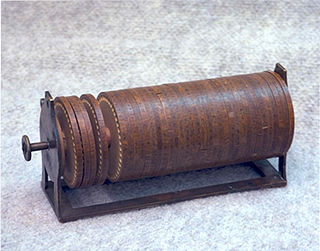This article needs additional citations for verification. (July 2019) |

The Jefferson disk, also called the Bazeries cylinder or wheel cypher,[1] was a cipher system commonly attributed to Thomas Jefferson that uses a set of wheels or disks, each with letters of the alphabet arranged around their edge in an order, which is different for each disk and is usually ordered randomly.
Each disk is marked with a unique number, and a hole in the center of the disks allows them to be stacked on an axle. The disks are removable and can be mounted on the axle in any order desired. The order of the disks is the cipher key, and both sender and receiver must arrange the disks in the same predefined order. Jefferson's device had 36 disks while Bazeries' system had 20.[2][3]
Once the disks have been placed on the axle in the agreed order, the sender rotates each disk up and down until a desired message is spelled out in one row. Then, the sender can copy down any row of text on the disks other than the one that contains the plaintext message. The recipient has to arrange the disks in the agreed-upon order, rotate the disks so they spell out the encrypted message on one row, and then look around the rows until they see the plaintext.
- ^ "Wheel Cipher". The Jefferson Monticello. Retrieved 19 March 2022.
- ^ Kahn 1967, p. 194.
- ^ Bazeries, Etienne (1901). Les Chiffres Secrets Dévoilés. Paris: Librairie Charpentier et Fasquelle. p. 250. Retrieved 7 October 2023.